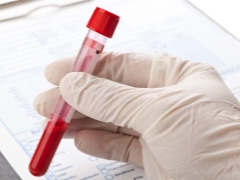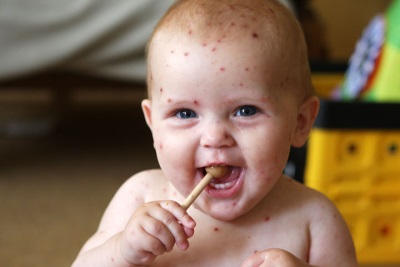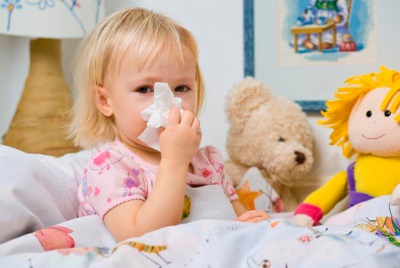A child's leukocyte count is lowered in the blood.
The blood test results of children are very important because they allow you to assess whether the child is healthy or has any disease that requires medical care. One of the most important indicators is the number of leukocytes. Depending on the different pathologies and external factors, this number may vary. In what cases determine the white blood cells below normal and is it dangerous for the child's health?
How much is considered reduced
White blood cells are called white blood cells that protect the body from various adverse factors, such as infections. Their number may vary during the day, after exercise, changes in temperature, food intake and other factors. In this case, the lower limit of the norm in a child is:
|
Have a newborn |
10 x 109/ l |
|
In 1 month |
8 x 109/ l |
|
In 1 year |
7 x 109/ l |
|
In 5 years |
6 x 109/ l |
|
At the age of 15 |
5 x 109/ l |
Leukopenia is diagnosed by a decrease of more than 2 x 109/ l from the age norm.
Causes of Leukopenia
The decrease in the number of white blood cells is due to:
- Lack of substances that are required for the formation of such blood cells. Such substances include vitamins of group B, ascorbic acid, iron, zinc, selenium, proteins, iodine and many other compounds. If they are insufficient, the child will also decrease the number of red blood cells and the amount of hemoglobin.
- Destruction of white blood cellswhich can be caused by bacterial infections, medications, toxins, and many other factors.
- Immune response to viral infectionin which the leukocytes move into tissues affected by the virus, and in the bloodstream they become smaller, although in general the number of leukocytes in the body does not decrease.
- Impaired bone marrow function. The development of leukocytes in it can be inhibited by certain genetic diseases, a tumor process, poisons, ionizing radiation, chemotherapy and autoimmune processes.
We recommend to watch the informative video, which highlights the problem of low levels of leukocytes in children:
Leukopenia is observed:
- With viral infections, for example, varicella, mononucleosis or rubella. A reduced rate in such diseases is noted for some time after recovery.
- When hypovitaminosis, as well as in case of malnutrition (fasting).
- With low blood pressure.
- With aplastic anemia.
- With purulent infections and septic lesion.
- In the final stages tumorsas well as acute leukemia.
- With systemic diseases. Leukopenia is noted for rheumatoid arthritis, as well as for lupus erythematosus.
- After treatment with cytotoxic drugs, which are most often prescribed for tumors. The reduction of leukocytes also provokes the use of steroids, antibiotics, anti-inflammatory, anticonvulsants and some other drugs.
- After exposure to radiation. Such rays inhibit the production of leukocytes, so their decline will be with radiotherapy or radiation sickness.
- With severe allergies (anaphylactic shock).
- With endocrine diseases, for example, with lesions of the thyroid gland (hypothyroidism) or with diabetes mellitus.
- With hyperfunction of the spleen, with the result that blood cells are destroyed in greater numbers.
Leukocyte changes
Assessment of leykoformuly and its changes helps in the diagnosis of various diseases. For example, leukocytes and neutrophils are reduced in a child with chickenpox, and leukocytes and lymphocytes decrease in immunodeficiency or tuberculosis.
The most common causes of a decrease in the number of individual forms of white blood cells are presented in the table:
|
Neutropenia |
Viral infection Kostman's syndrome Acute leukemia Hypothyroidism Chemotherapy Some medications Radiotherapy Hypersplenism B12 deficiency anemia Pancreatic disorders |
|
Eosinopenia |
The initial stage of inflammation Heavy metal poisoning Reception of glucocorticoids Purulent infection |
|
Monocytopenia |
Period after surgery Acceptance of steroid drugs Purulent lesion of soft tissues and bones Sepsis Depletion of the body |
|
Lymphocytopenia |
Reception of glucocorticoids Tuberculosis Chemotherapy Systemic lupus erythematosus Aplastic anemia Congenital Immunodeficiency Renal failure Myeloma Radiation sickness Lymphoma HIV infection Lymphogranulomatosis |
Symptoms
What to do
If leukopenia is found in a child during a routine examination, it is necessary to contact the doctor for an analysis and get a more detailed examination. With a slight decrease in the rate and detection of hypovitaminosis, the child will be given vitamin preparations and will correct the diet.
If additional examinations have confirmed any disease, the doctor will prescribe the desired drug treatment.
As soon as the main disease is cured and the child recovers, within a few weeks the number of white blood cells will recover.
Parents should be aware that reduced white blood cells are a risk factor for the "joining" of the infection, so they should pay attention to such nuances:
- All food for the child should be subjected to thorough heat treatment, and vegetables and fruits should be washed and then cleaned.
- Do not give your baby boiled water or raw milk.
- Farm products temporarily cancel and buy for the child dairy products in original packaging.
- Put your child in a protective mask when heading to public places.
- Avoid contact with sick people. If a mother or another close relative has ARVI, they should wear a mask so as not to pose a danger to a child with leukopenia.
For more information about the clinical analysis of blood, see the transfer of Dr. Komarovsky.















